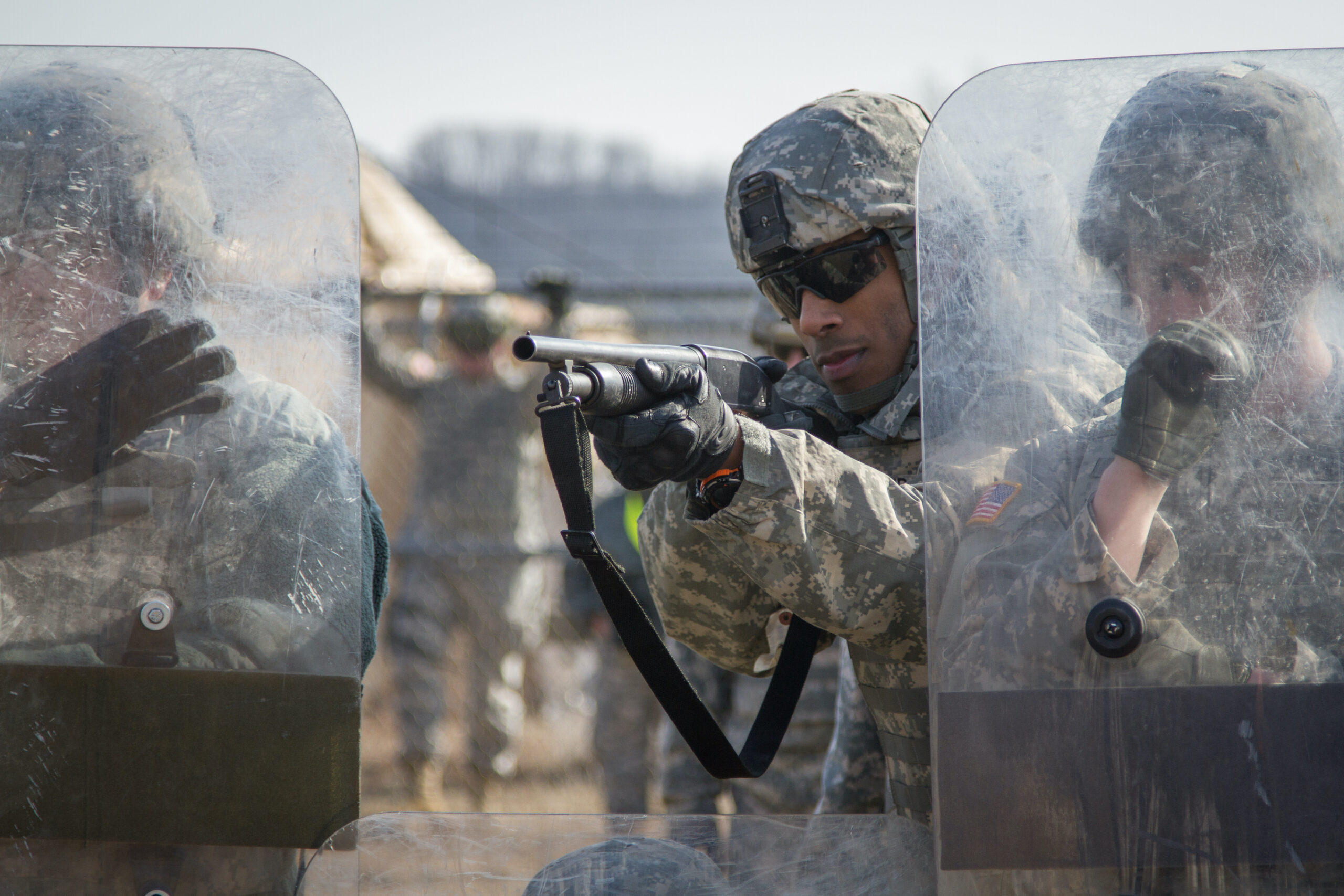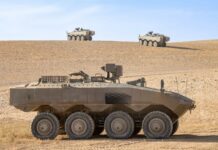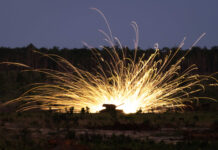The shotgun might not have the ‘glamour’ of some other small arms, for instance it cannot successfully engage a target at 600 m. However in urban combat scenarios, the weapon truly comes into its own.
At present many militaries are working towards the development and fielding of new generations of small arms that combine high capability, high technology and, inevitably, high cost. This is unsurprising when you consider that next-generation assault/battle rifles are to be equipped with digital fire control systems, designed to allow the shooter to successfully engage a target and neutralise it with minimal expenditure of rounds. Yet for all its capability, the service rifle is not a universal panacea. There are other operational and specific mission requirements where something different is the correct tool for the job. This sums up the role of the shotgun.
The shotgun has often suffered from the fact that it really does not have a martial image. It is not an elegant weapon, nor is it particularly accurate weapon when used outside of its parameters. However, to the surprise of many, the shotgun is actually a uniquely flexible weapon system. In recent years shotgun capabilities have been significantly increased, further enhancing its utility for military users, as well as paramilitary and law enforcement (LE) agencies.

Credit: USMC
Manufacturer Diversity
If you are in the market to acquire a shotgun-type capability it is quite likely to be a considerable surprise when you suddenly discover how many shotgun manufacturers there actually are. Even more surprising will be the price points that the various manufacturers operate at.
Beretta is a diverse group capable of meeting most small arms needs, but their capabilities have also expanded into ammunition and optics amongst other areas. In terms of shotguns, Beretta are more than capable of producing weapons that could compare with the high-end providers such as Purdey and Holland & Holland, the latter of which was acquired by Beretta in 2021. However, Beretta is also a major producer of shotguns for military applications. Alongside its own range, Benelli and Franchi, two major names in the military, paramilitary and LE shotgun market are also Beretta Group companies.
In 2022, Australia’s LAND 159 Lethality System Project Tranche 1 included the Australian Defence Force (ADF) Close Combat System, part of which is the acquisition of a new Combat Shotgun System. In September 2022, it was announced that the Benelli M3A1 had been selected to meet the Combat Shotgun System requirement and would replace the Remington 870 in ADF service. The Benelli M3A1 offers a selective action – it can be used in a semi-automatic recoil inertia operated mode, or the user can switch to a manually-operated pump action mode. This is a 12 gauge weapon with an eight round magazine. For the ADF application it will also be fitted with a red dot sight and white light illuminator.

Credit: Australian DoD
There used to be substantially more shotgun manufacturers in Europe than there are today, even so apart from Italy and the UK, there are shotgun solutions on offer from Belgium, France, Germany, Israel, Russia and Ukraine. Expand your search and shotgun possibilities emerge from Brazil, China, the Republic of Korea, the Philippines, South Africa, Turkey and, of course, the US. To be fair, there are still a substantial number of manufacturers globally, but the number who could supply weapons for military and other demanding applications are inevitably far fewer in number.
Market Options
While European manufacturers can justly claim to have the historical background in shotgun design and manufacture, US manufacturers can point to the fact that the US military has, in many ways, led the practical application of shotgun usage in the military sphere. Back in 1893, John Moses Browning, one of the truly great firearms designers, and his brother Matthew S. Browning developed a new shotgun design for the Winchester Repeating Arms Company, the definitive version being the Model 1897. Thereafter referred to as the Model 97, this was one of the first successful pump action shotguns. It was 12 gauge with a five-round magazine.
Initially developed for LE and prison guards, it was described as a ‘riot gun.’ When the US Army joined World War 1 in 1917, the Model 97 was re-purposed as ‘trench gun’ and was found to be an ideal weapon for close combat trench clearance. Another Winchester shotgun was the Model 12, this was developed by a company engineer in 1912, and later was given the M12 designation by the US military. Both of these weapons would remain in service until the early 1960s.
The next generation of military shotguns were developed as a replacement for the Model 97 and the M12. Winchester developed the Model 1200 in the early 1960s for LE use, although the US military purchased a few. The Winchester Model 1200 was superseded by the Model 1300 in the 1980s, but by that point others were meeting LE and military needs. The Remington 870 arrived in the early 1950s, but it took until 1966 and an order from the US Marine Corps for it to see military service. Then in the 1970s, the US Army would acquire the weapon.
Mossberg is one of the major shotgun manufacturers in the US and was first established in 1919. Its product range covers pistols and rifles as well as shotguns, with the company getting involved in military production in 1940. At that point it was manufacturing weapon parts and tooling gauges, it even manufactured Lee Enfield rifle parts for supply to Britain. At the start of the 1960s Mossberg introduced their Model 500 shotgun, which was highly successful in commercial and LE markets. In terms of military applications, 1979 was the key year when the US military adopted the Model 500 as its standard shotgun. In the late 1980s, the Model 590A1 shotgun would be purchased by the US military. The weapon was widely sold internationally, and Mossberg went on to develop the 590M variant, which is fed from a detachable box magazine available in 5, 10, 15 or 20 round formats. Mossberg shotguns are still in US military service.
In May 1998, the US Army issued an invitation to tender for a new semi-automatic 12-bore combat shotgun, contender evaluations took place in August of that year, and in early 1999 the Benelli M4 Super 90 was selected as the competition winner and type classified as the M1014 for the US military. The British Army also uses the M4, designated as the L128A1, as its combat shotgun, with Special Forces also using the Remington 870 as the L74A1/A2. The French Army has chosen a different path for its combat shotgun requirement, it has a limited number of Benelli M4, Mossberg Model 500 and a few Remington 870s. In May 2022 it was revealed that the new standard French military combat shotgun would be the Benelli Supernova Tactical.

Credit: UK MoD
Something a bit different in terms of combat shotguns comes from Israel Weapon Industries (IWI) and is based on their Tavor TAR-21 bullpup assault rifle design. Originally the Tavor was designed in 5.56 × 45 mm to allow the Israel Defence Forces (IDF) to replace older weapons such as the M16 in first-line service, the weapon also proved attractive to export customers. For combat shotgun requirements IWI developed the Tavor TS12, it followed a lot of the standard Tavor styling cues and has a bullpup configuration.
The TS12 has three separate magazine tubes, giving a capacity of 15 rounds or 16 with one in the chamber. The weapon has a Picatinny rail on top as well as M-LOK compatible rails, allowing a wide selection of sights and other accessories to be fitted to the weapon.
Back in October 2021, French manufacturer Verney-Carron, which had been established in Saint-Etienne in 1820, decided to re-organise and separate its commercial and sport shooting activities from its defence and security activities. These were combined under a new name as the Lebel company, a name drawn from that of the famous French weapon designer Colonel Nicolas Lebel, whose 1886 rifle along with its smokeless rounds was a revolution in small arms design.
Lebel has a complete range of less-than-lethal systems utilising Flash-Ball grenades, rubber bullets and CS gas rounds. Alongside rifles and submachine guns, the company also has a complete shotgun range, comprising the VERTAC A2, D2, and P2 models. The VERTAC A2 is a semi-automatic shotgun, the VERTAC P2 is a pump action shotgun, while the VERTAC D2 is a dual action semi-automatic or pump action system. All of these systems are used by French LE particularly in terms of riot control and by rapid intervention units.
The Right Tool for Urban Combat
As a system the shotgun has been around for hundreds of years, its debut as a significant modern military system came in World War 1 when the US Army started using the pump action shotgun for trench clearance. Since then the shotgun has retained its military relevance and remains an ideal tool for close-quarter battle environments. As a door-breeching system, shotguns provide capability for both military and LE operators. Initially LE was the primary user of shotguns for crowd/riot control, at the start buckshot rounds were used, but over time a range of less-than-lethal rounds have emerged for this purpose. Crowd/riot control is increasingly also a military mission, hence they also require less-than-lethal rounds for their combat shotguns.
Continuing urbanisation around the world means that combat operations in urban environments will increasingly become the norm. The combat shotgun remains an essential capability for operations in these environments, be they close-quarter work or breaching operations. Operating in these urban environments, especially amongst potentially or truly hostile civilian populations, will require that the military has crowd/riot control means with less-than-lethal munitions, yet another mission for the shotgun.
David Saw












